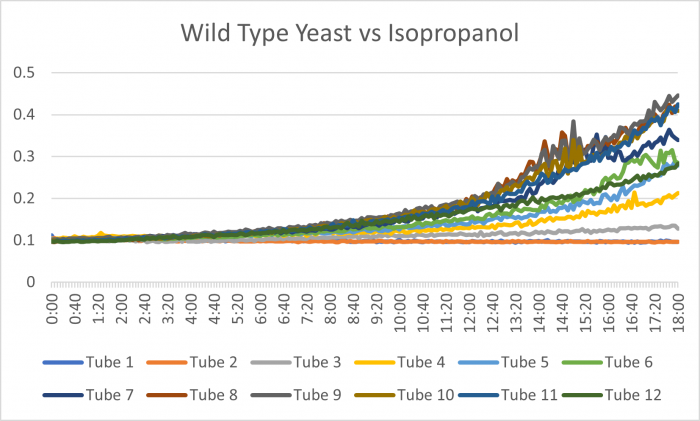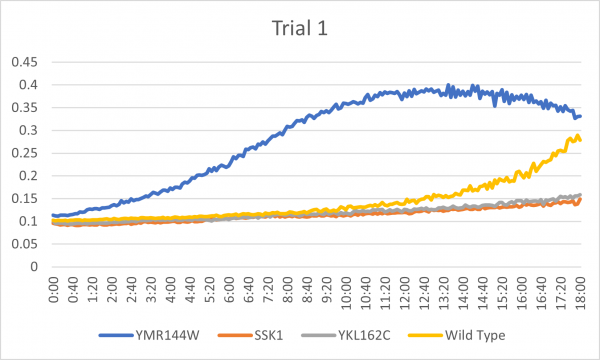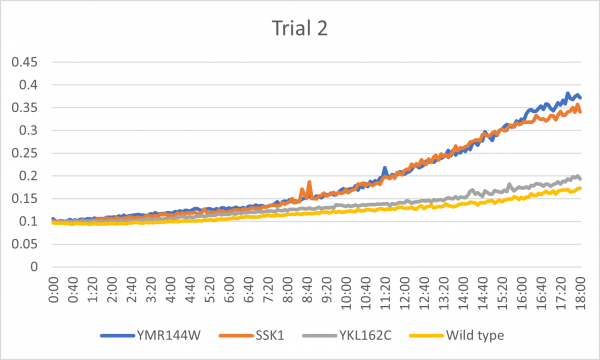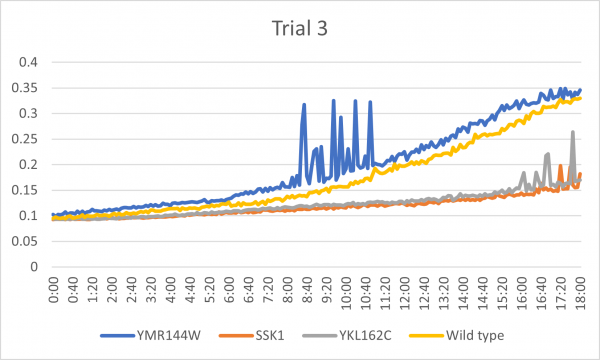Difference between revisions of "UW-Stout/Isopropanol SP23"
(→Analysis) |
|||
| Line 65: | Line 65: | ||
===Analysis=== | ===Analysis=== | ||
| − | We used tube 5 as the stress on the knockout genes because it gave median data. The yeast was able to grow but we saw that it didn’t grow as well as tube 12 which only had water. Tube 5 had 4ul of 100% isopropanol and 96ul of sterile water which was a good stressor on the yeast as is shown in the graph. | + | We used tube 5 as the stress on the knockout genes because it gave median data. The yeast was able to grow but we saw that it didn’t grow as well as tube 12 which only had water. Tube 5 had 4ul of 100% isopropanol and 96ul of sterile water which was a good stressor on the yeast as is shown in the graph. Overall the graph had a good growth curve and was consistent with the predicted results. |
==Knockout Yeast Isopropanol Stress Experiment== | ==Knockout Yeast Isopropanol Stress Experiment== | ||
Latest revision as of 10:55, 2 May 2023
Contents
Wild Type Yeast Isopropanol Stress Experiment
Introduction
We are going to introduce the wild type yeast to isopropyl alcohol as a stress to see how it reacts if at all.
Materials
- 100% Isopropyl alcohol
- Room temp
- Wild Type yeast tube
- BY4735
- Sterile water
- 96 well plate
- 12 microcentrifuge tubes
Procedure
Diluting the Isopropyl alcohol
- Compute the volume of your 100% isopropyl to achieve a dilution of 50%, 10%, and 5%.
Creating Stock Solutions
- In the first microcentrifuge tube add 100ul of 100% isopropyl.
- In the second microcentrifuge tube add 40ul of 100% isopropyl to 60ul of sterile water.
- In the third microcentrifuge tube add 20ul of 100% isopropyl to 80ul of sterile water.
- In the fourth microcentrifuge tube add 10ul of 100% isopropyl to 90ul of sterile water
- In the fifth microcentrifuge tube add 4ul of 100% isopropyl to 96ul of sterile water
- In the sixth microcentrifuge tube add 2ul of 100% isopropyl to 98ul of sterile water
- In the seventh microcentrifuge tube add 2ul of 50% isopropyl to 98ul of sterile water
- In the eighth microcentrifuge tube add 4ul of 10% isopropyl to 96ul of sterile water
- In the ninth microcentrifuge tube add 2ul of 10% isopropyl to 98ul of sterile water
- In the tenth microcentrifuge tube add 4ul of 5% isopropyl to 96ul of sterile water
- In the eleventh microcentrifuge tube add 2ul of 5% isopropyl to 98ul of sterile water
- In the twelfth microcentrifuge tube add 100ul of sterile water for the control
Mixing diluted isopropyl and yeast cells
- Vortex the yeast culture briefly to resuspend the yeast cells
- Add 50ul of wild type yeast to each well labeled 1-12
- Starting in well 1 add 50ul of the contents of microcentrifuge tube 1
- Repeat this process with microcentrifuge tubes 2-12 adding 50ul in their respected wells labeled 2-12
Data
Analysis
We used tube 5 as the stress on the knockout genes because it gave median data. The yeast was able to grow but we saw that it didn’t grow as well as tube 12 which only had water. Tube 5 had 4ul of 100% isopropanol and 96ul of sterile water which was a good stressor on the yeast as is shown in the graph. Overall the graph had a good growth curve and was consistent with the predicted results.
Knockout Yeast Isopropanol Stress Experiment
Introduction
We are going to introduce the knockout gene yeast to isopropyl alcohol as a stress to see how it reacts if at all. We are using the amount of isopropyl that affected the growth of the yeast but did not kill it which was series 5 from the wild type yeast experiment.
Materials
- 100% Isopropyl alcohol
- Room temp
- 3 knockout gene yeast tubes
- YMR144W
- SSK1
- YKL162C
- Wild type yeast tube
- BY4735
- Sterile water
- 96 well plate
- 1 microcentrifuge tube
Procedure
Diluting the Isopropyl alcohol
- In the microcentrifuge tube add 8ul of 100% isopropyl to 192ul of sterile water
Mixing diluted isopropyl and knockout gene yeast cells
- Vortex the yeast culture briefly to resuspend the yeast cells
- Add 50ul of YMR114W yeast into the first well
- Add 50ul of SSK1 yeast into the second well
- Add 50ul of YKL162C yeast into the third well
- Add 50ul of BY4735 wild type yeast in the fourth well
- Add 50ul of the contents in the microcentrifuge tube to each of the 4 wells



